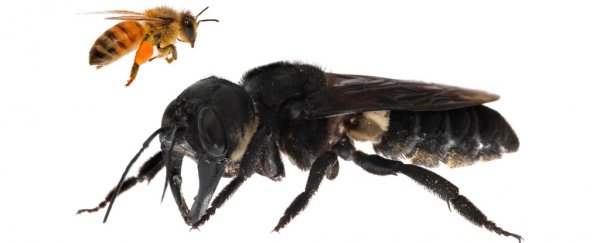Looking at a picture of Wallace's giant bee, you wouldn't pick this insect as elusive.
Four times as big as a honeybee, and a stark black colour, it looks like the security guard or bouncer of the bee world. But researchers have just released the first photos and video of a live Wallace's giant bee (Megachile pluto) ever taken – a species that has been lost to science since 1981.
How it stayed hidden is mind-boggling. The females (or queens) have wingspans of more than six centimetres (2.5 inches); it's the world's largest known living bee species.
They live in arboreal termite mounds (that's termite mounds in trees) on a few of the northern Maluku islands in Indonesia, and use their huge mandibles to collect tree resin to line the nest, keeping termites out of their area of the mound.
 (Simon Robson)
(Simon Robson)
The scientific history of this giant bee is honestly pretty short. Back in 1858, British naturalist Alfred Russel Wallace (a contemporary of Charles Darwin) first collected the bee and it was given the common name Wallace's giant bee.
This was the last scientific sighting of the bee - it was even thought to be extinct – until rediscovery over 100 years later in 1981 by entomologist Adam Messer.
He found six nests in the Bacan Islands, and managed to find out some important information about its nesting and physiology; since then, there had been no new sightings.
Now, this is partly to do with location. Northern Maluku is pretty remote, especially the areas where these bees would hang out.
Sadly, the IUCN Red List classes Wallace's giant bee as vulnerable, "due to mining and to the impacts of invasive plant species" in the area.
Which brings us up to the present day. Late last month, a group of four researchers - Glen Chilton, Eli Wyman, Clay Bolt and Simon Robson - all from different scientific backgrounds and institutions across the globe, set off to Indonesia to see if they could find the elusive bug.
"Glen and I became aware that Eli and Clay were also planning to search for the bee. We decided to join forces, met for the first time in Indonesia and travelled into the field together. Each of us brought our own expertise, we couldn't have found it without everyone's involvement, it was a fantastic group effort," Robson told ScienceAlert.
"I brought expertise as a specialist in the study of insect behaviour. I also tried to ensure there were cold beers available each night to help us recuperate."
It wasn't an easy task, and for five days they travelled through the forest of North Maluku, staring at termite mounds for twenty minutes at a time, trying to see if they could notice any movement that would give away the bee.
On the last day, it was actually one of their Indonesian guides, Iswan Maujud, who spotted a low termite mound, and first laid eyes on the bee's nest.
"Iswan, ever the eagle eye, spotted a low termite mound, around eight feet from the ground … we immediately noticed that it had a hole in it, like many other nests we'd seen, but this one was a little more perfect. It was very round, and just the size that a giant bee might use," explained Bolt in an article about the expedition over at Global Wildlife.
"I climbed up next and my headlamp glinted on the most remarkable thing I'd ever laid my eyes on. I simply couldn't believe it: we had rediscovered Wallace's giant bee."
 Simon Robson holding the bee specimen. (Clay Bolt)
Simon Robson holding the bee specimen. (Clay Bolt)
The team took videos and pictures of the huge bee, and then returned her to her nest.
But the researchers aren't done yet. Because there have been so few, short sightings of the bee, we still know very little about it.
"It challenges us to understand many aspects about its evolution, behaviour and role in the environment," said Robson.
"Are they specialised plants that depend on this species for pollination, for example. How does the sensory system of an insect this big work? What is its social biology?"
The team is now working with Indonesian collaborators to find the bee in other locations, and discover more about it.
"To join with a group of like-minded individuals and immerse ourselves in the biology of the region was fantastic. To be able to rediscover this species together, we hope will have positive results for conservation biology generally," said Robson.
"It was one of the best holidays I have ever had."
